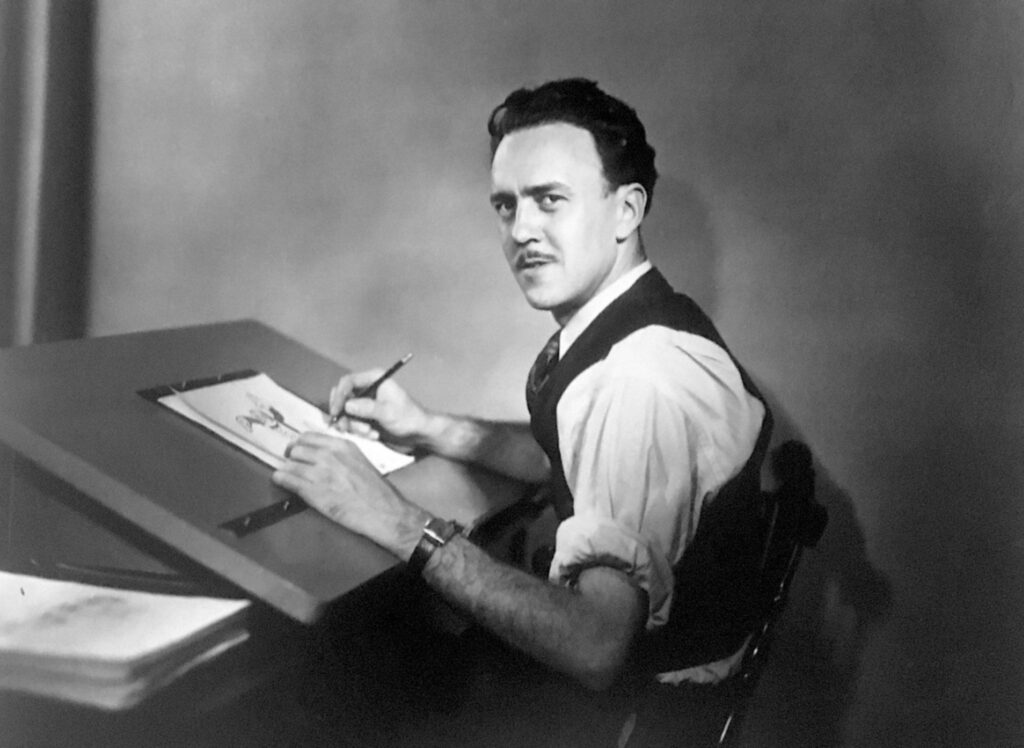Oswald, the Lucky Rabbit, is a beloved character in animation and entertainment. Created by Walt Disney and Ub Iwerks, Oswald has significantly impacted the development of the animated medium. He has become an iconic figure in the history of animation.
Name: Oswald the Lucky Rabbit
Series: Disney
First: “Trolley Troubles” (1927)
Created by: Walt Disney and Ub Iwerks
Full name: Oswald the Lucky Rabbit
Species: Rabbit
Gender: Male
Occupation: Various roles in Disney media
Significant other: Ortensia (girlfriend)
Creation and Introduction
Oswald, the Lucky Rabbit, was first introduced to audiences in the animated short film “Trolley Troubles” in 1927. Walt Disney and Ub Iwerks created him while working for Universal Studios. Oswald quickly gained popularity due to his charming personality, mischievous nature, and unique design, including long ears and a distinctive laugh.

Characteristics
The Lucky Rabbit Oswald is characterized as a clever and adventurous anthropomorphic rabbit. He is known for his playful and mischievous antics, often finding himself in humorous and daring situations. Oswald is carefree and optimistic, which adds to his charm and relatability.
Oswald the Lucky Rabbit’s design captures the essence of classic animation with his iconic red shorts and white gloves. This distinctive appearance pays homage to the animation style of his era. Oswald’s friendly demeanor and infectious enthusiasm have endeared him to audiences of all ages, adding to his timeless charm.

Popularity and Impact
During his initial run in the late 1920s, Oswald the Lucky Rabbit gained immense popularity. He starred in dozens of animated shorts produced by Universal Studios. The character’s popularity and Walt Disney’s growing expertise in animation led to negotiations for a new contract.
However, a disagreement over ownership rights between Disney and Universal resulted in Oswald being taken away from Disney. This loss was a turning point in Disney’s career and prompted him to create a new character, which eventually became Mickey Mouse.
Despite his temporary absence from the Disney studio, Oswald’s influence on animation and the entertainment industry continued to be felt. His mischievous personality and the technical advancements made during his creation laid the foundation for future animated characters and stories.

Rediscovery and Revival
2006 The Walt Disney Company negotiated to reclaim Oswald the Lucky Rabbit from Universal Studios. After a complex and historic agreement, Oswald returned to the Disney family nearly eight decades after his departure.
Since his return, Oswald has been reintroduced to audiences through various media. He has appeared in video games, comic books, and merchandise and made notable appearances in Disney theme parks. Oswald’s revival has allowed new generations to appreciate and enjoy his timeless charm and humor.

Legacy
Oswald, the Lucky Rabbit’s legacy, extends beyond his time on screen. His creation was a stepping stone in Walt Disney’s career and vital to animation development. Oswald’s influence can be seen in the evolution of animated characters, storytelling techniques, and the success of the Walt Disney Company.
The story of Oswald’s temporary loss and eventual return highlights the significance of intellectual property rights and has served as a lesson in the importance of creative ownership and the protection of artistic endeavors.
FAQ
Here are some frequently asked questions (FAQ) about Oswald the Lucky Rabbit:
Q: Who is Oswald the Lucky Rabbit?
A: Oswald, the Lucky Rabbit, is an iconic animated character created by Walt Disney and Ub Iwerks. He is an anthropomorphic rabbit known for his mischievous nature and adventurous spirit.
Q: When was Oswald the Lucky Rabbit created?
A: Oswald was first introduced in the animated short film “Trolley Troubles” in 1927.
Q: What makes Oswald “lucky”?
A: Oswald is called the “Lucky Rabbit” because he can overcome challenges and find himself in fortunate situations during his animated adventures.
Q: What is Oswald’s personality like?
A: Oswald is characterized as clever, playful, and mischievous. He possesses a carefree and optimistic attitude, making him an endearing and relatable character.
Q: Why is Oswald significant in the history of animation?
A: Oswald played a crucial role in the development of animation. His creation by Walt Disney and Ub Iwerks marked a milestone in advancing animated characters and storytelling techniques.
Q: What happened to Oswald’s ownership?
A: After the initial success of Oswald, a dispute over ownership rights between Disney and Universal Studios led to Oswald being taken away from Disney. This loss prompted Disney to create a new character, Mickey Mouse.
Q: How was Oswald rediscovered?
A: In 2006, The Walt Disney Company engaged in negotiations to reclaim the rights to Oswald the Lucky Rabbit. After a historic agreement, Oswald returned to the Disney family nearly eight decades after his departure.
Q: How has Oswald been revived?
A: Since his return, Oswald has appeared in various media, including video games, comic books, merchandise, and special appearances in Disney theme parks. His revival has introduced him to new generations of fans.
Q: What is Oswald’s legacy?
A: Oswald’s legacy extends beyond his time on screen. His creation influenced the evolution of animation and storytelling techniques. His story of temporary loss and eventual return highlights the importance of creative ownership and intellectual property rights.
Q: Where can I find more information about Oswald the Lucky Rabbit?
A: Additional information about Oswald can be found on the official Disney website or through reliable sources such as books, articles, and online databases dedicated to Disney characters and animation history.




One Comment